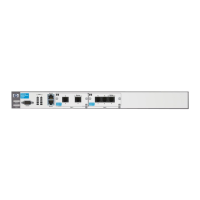10-22
Bridging—Transmitting Non-IP Traffic or Merging Two Networks
Configuring Spanning Tree
By default, the ProCurve Secure Router uses the auto option to determine the
connection type. RSTP assumes that full-duplex interfaces are point-to-point
and half-duplex interfaces are shared.
If, for whatever reason, you must override this setting, move to the logical
interface’s configuration mode context and enter this command:
Syntax: spanning-tree link-type [auto | point-to-point | shared]
For example, the Ethernet interface 0/1 connects to a hub. Enter:
ProCurve(config-eth 0/1)# spanning-tree link-type shared
Altering Timers
Caution You should not alter spanning tree timers unless you have a great deal of
experience working with spanning tree.
You configure the timers from the global configuration mode context. Use the
commands shown in Table 10-3.
Table 10-3. Spanning Tree Timers
Forward Timer. The forwarding interval determines how long a device waits
to forward BPDUs. With STP, this setting determines how long the device stays
first in the listening and then in the learning stage.
Hello Timer. Interfaces periodically transmit hellos. If an interface misses
three hellos, neighbors assume the connection is down and send out TCN
BPDUs to this effect. Take care when altering this timer because incompatible
settings can cause devices to believe a connection is down when it is not.
Timer Function Default Range Command Syntax
forward timer minimum time
between forwarding
BPDUs
15 seconds 4 to 30 spanning-tree
forward-time
<seconds>
hello timer time between hellos 2 seconds 0 to 10 spanning-tree hello-
time <seconds>
maximum age timer how long a BPDU
remains valid
20 seconds 6 to 40 spanning-tree max-
age <seconds>

